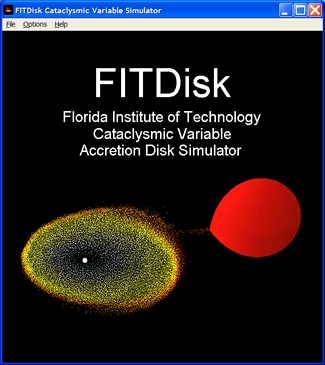DiskSim / FITDisk
We have released the source code for our smoothed particle hydrodynamics (SPH) accretion disk code on the Astrophysics Source Code Library (ascl.net/1811.013), or you can download it below. DiskSim is a source-code distribution of the SPH accretion disk modeling code described in Simpson & Wood (1998) and Wood, Thomas, & Simpson (2009). The code had been released earlier in a Windows executable form as FITDisk (Dolence, Wood & Simpson 2005; ascl:1305.011). The code released now is the full research code in Fortran, which can be modified as needed by the user.
 We have availalbe the Windows executable FITDisk, our cataclysmic variable (CV) accretion disk simulator, if that should be useful to you (and if it still runs on more modern Windows operating systems). FITDisk is a 3-D smoothed particle hydrodynamics code which simulates accretion disk formation and evolution in CVs. It provides an easy to use graphical user interface as well as 3-D interactive graphics. The current version of the code has the following capabilities: computes the evolution of a CV accretion disk, visualizes results in real time, records and plays back simulations, and generates and plots pseudo light curves and associated power spectra.
We have availalbe the Windows executable FITDisk, our cataclysmic variable (CV) accretion disk simulator, if that should be useful to you (and if it still runs on more modern Windows operating systems). FITDisk is a 3-D smoothed particle hydrodynamics code which simulates accretion disk formation and evolution in CVs. It provides an easy to use graphical user interface as well as 3-D interactive graphics. The current version of the code has the following capabilities: computes the evolution of a CV accretion disk, visualizes results in real time, records and plays back simulations, and generates and plots pseudo light curves and associated power spectra.
FITDisk was developed by putting a user-friendly graphical user interface (GUI) front-end onto our research hydrodynamics code. Our goal with this project has been to make the hydrodynamics simulations of CVs possible for interested amateur astronomers, students, and professionals. Whether in an instructional setting or at home on a personal computer, FITDisk can be a fun, easy way to learn about these exotic systems and to build a better physical intuition for accretion disk dynamics. Amateurs and professionals alike often observe CVs, yet no simple means exist by which one can visualize and experiment with these phenomena. FITDisk was designed to fill that gap, providing an opportunity to gain a greater understanding of how these systems behave under a wide range of conditions.
In addition, FITDisk has its origins in a research code, and apart from the addition of the GUI and OpenGL® based visualization, has been modified only slightly from its original form. Thus, it provides a unique opportunity for the non-specialist to use research-grade simulation software using readily available computer hardware and without requiring advanced programming skills.
Downloads:
- DiskSim Source Code (.tar.gz)
- FITDisk Executable and Help File (.zip)
- FITDisk Manual (.pdf)
